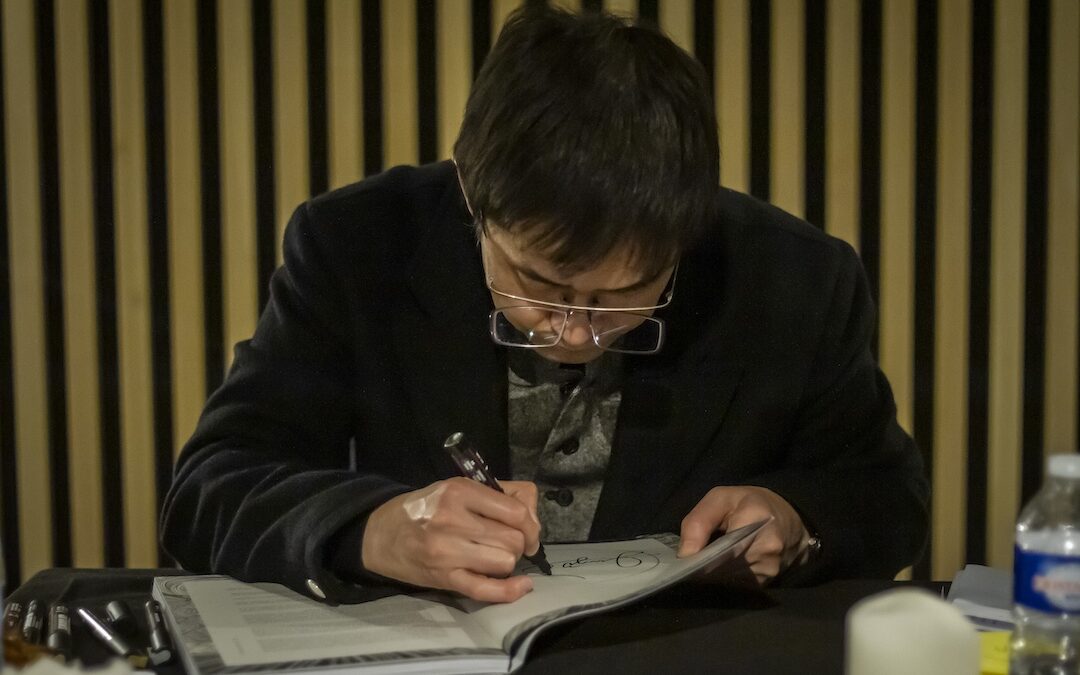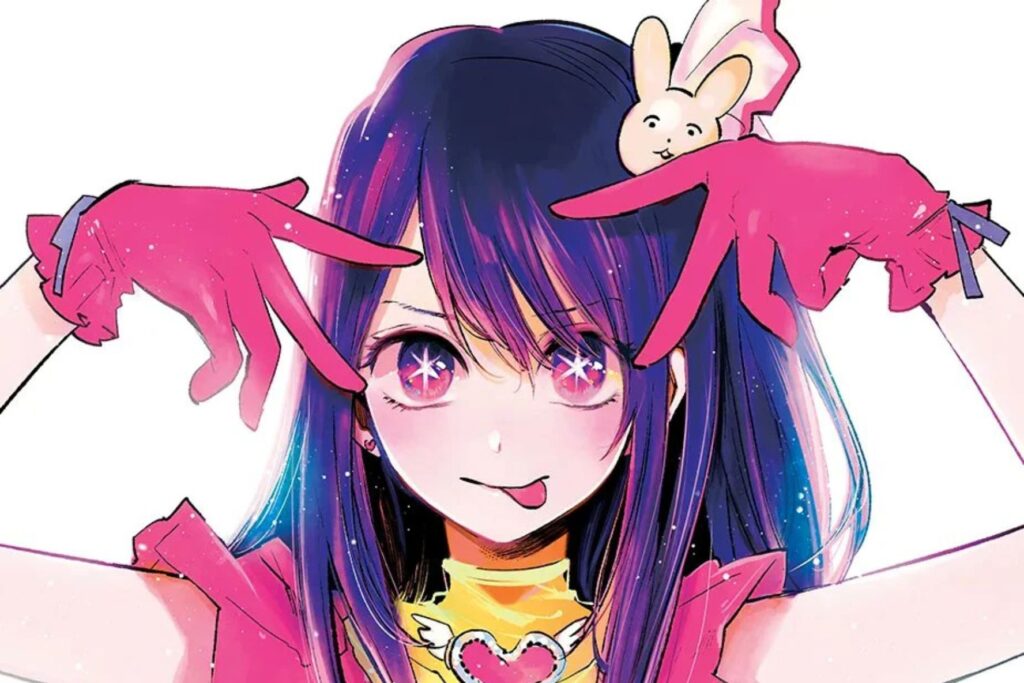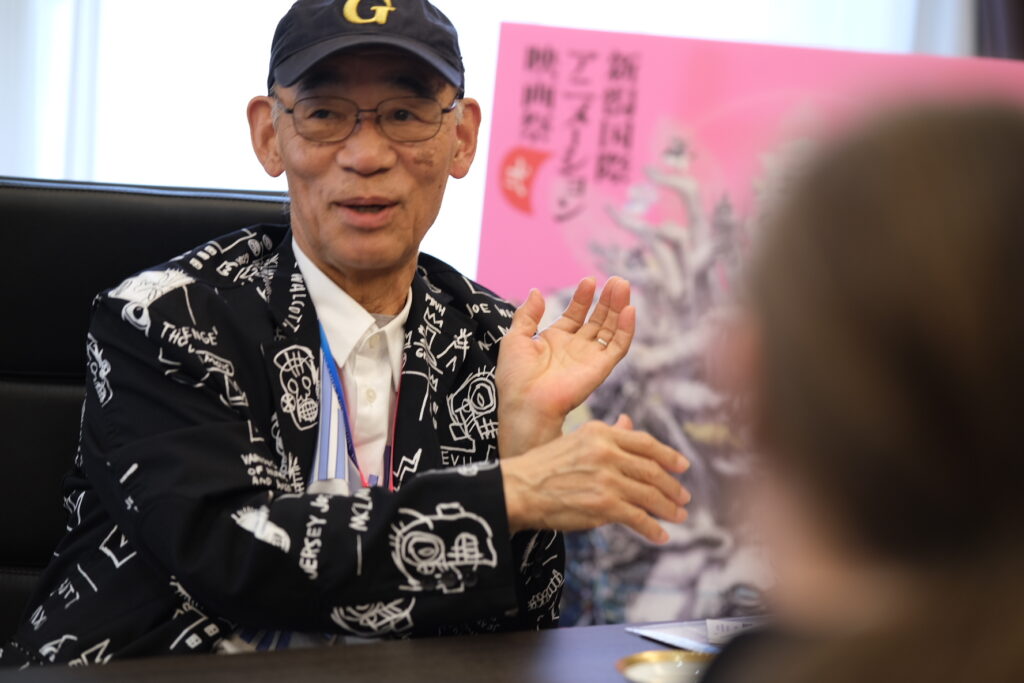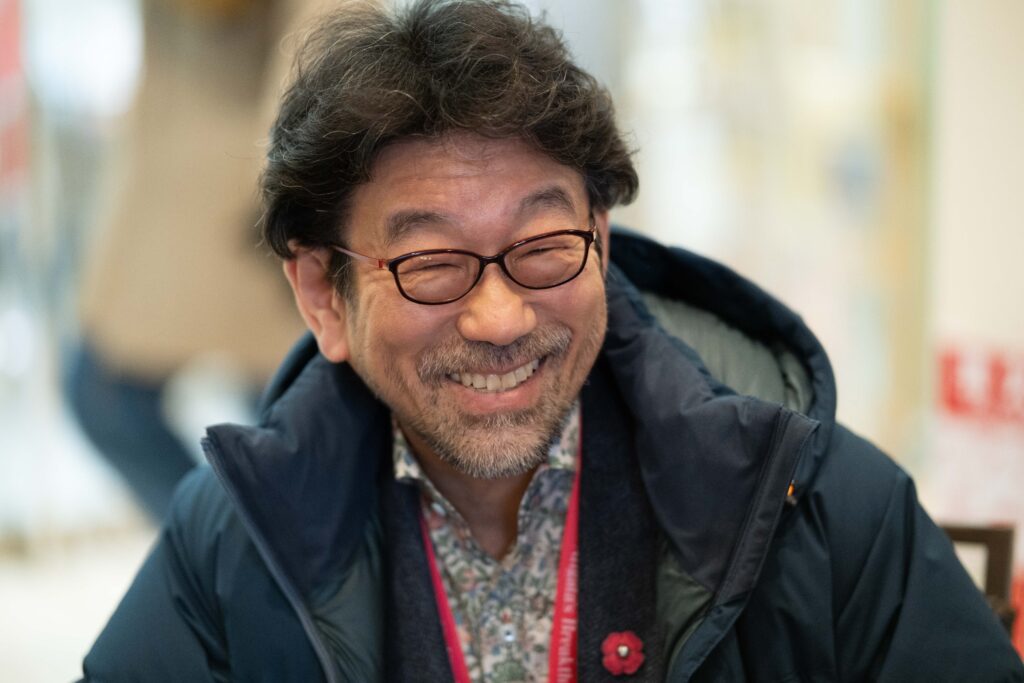This interview with Junji Itô was initially published in French on my own website, Le Cabinet de McCoy. I’m happy to be able to share an international version of it thanks to my friends at fullfrontal.moe.
Junji Itô has become a household name when thinking of horror manga. Over 35 years have now passed since his first manga, Tomie, began publication in 1987 in Shôjo Horror Magazine Monthly Halloween. Uzumaki, Frankenstein, and his numerous anthologies of short stories prove his overflowing imagination and capacity to push his concepts to extremes.
Junji Itô is an artist that gained a lot of popularity in recent years, with his illustrations being shared everywhere online. In France, he has become a star of the comics world, as his invitation as guest of honor at the 50th Angoulême International Comics Festival attests. A gorgeous exhibition was dedicated to his work, and swarms of people would start lining up during the middle of the night to get the chance to meet with him.
Junji Itô had already come to Angoulême before, in 2015. At that time, he was still an underground figure in France as many of his mangas were unpublished or had been edited for the last time years ago. The festival was also much less manga-oriented than it is now.
Being given a chance to sit with him has been a true honor. I feel fortunate to have been able to share this moment with this very modest and heartfelt artist who loves his fans and makes everything possible to please them.
Like our content? Feel free to support us on Ko-Fi!
You already came to France in 2015, but today is a special occasion. How do you feel after this one-week marathon through France, going to Marseille, Paris, and here to Angoulême?
Junji Itô: Indeed, it is the second time I have gone to Paris and Angoulême, and I am able to recall some landscapes from my memory, which I am very happy about. It is true that French architecture and buildings have a very long history and are very artistic. It is unimaginable in Japan, and I appreciate Marseille’s landscapes. I really liked discovering all this. I went to the Catacombs in Paris. It was way more impressive than I thought. Meeting all the fans who came to the exhibition and the signing session made me happy.
What are your impressions about your dedicated exhibition at the festival and its setting? Can you dive into the exhibition’s atmosphere, although you are the creator of the works exposed?
Junji Itô: Seeing those on-paper drawings framed with refinement on the wall indeed makes them stand out. But in addition, there was all this scenery, remembering a traditional Japanese house, my drawings enlarged on the wall, and this scary sound work. It permitted me to have a new look at my very own works.
After a break of several years, what did Sensor and The Liminal Zone bring to you?
Junji Itô: I drew Sensor right after No Longer Human and wanted to talk about the mysteries of the universe in this story. I started it with complete freedom, I could do whatever I wanted, but this subject was so large that I ended up not totally satisfied with the result.
Then, for The Liminal Zone, I had a lot of consultations with my editor to prepare the work well each time, and I think this brought a lot. Plus, I had much more time to work on it because it is published online. I was less hurried by deadlines, and I could build my stories correctly. Between Sensor and The Liminal Zone, we have two extremes; Sensor, where I could do everything I wanted, and The Liminal Zone, where I prepared the work with my publisher, so those two works permitted me to experiment with those extremes.
In The Liminal Zone, the short story Madonna takes place in a Christian school. Where does your recent interest in religion and Christian mythology come from?
Junji Itô: In my circle, people told me the Bible has very interesting contents, so I bought myself a copy. I am not Christian, and I have not read everything in the Bible, but I thought it could constitute great elements to draw stories, just like Madonna. It is true that thanks to catholicism’s old age, we can find a wide variety of interesting episodes that I want to use in my stories.
To stay on the topic of The Liminal Zone, did you feel better with the freedom that working digitally brings? And what about being freed of the constraints from paper publication, such as the size of the paper and the number of pages?
Junji Itô: Concerning the digital workflow, it is true that working on paper is better. You can truly realize that you made a drawing. But, at the same time, working digitally has a lot of very useful tools. For example, I can make the dotting instantly on a large screen, so there is a great gain in speed and working ease. About the number of pages, not being limited brings great freedom. I feel that I can draw everything I want, and as an experience, I am grateful for being able to do it.
I want to ask you about the topics of your short stories compilations, especially the themes of sleep and dreams. I especially think about what you developed in Slumber and Long Dream. Do you have concepts like these that you want to deepen?
Junji Itô: It is true that dreams are something very strange. Just thinking about the question “Why do we dream?” intrigues me a lot, so if I find new interesting ideas, I would love to use them in my stories, and I am sure I will.
What can you tell us about your adaptation of Mary Shelley’s Frankenstein? Regarding the adaptation work, how did you breathe your horrific style into the original story?
Junji Itô: I don’t exactly remember what year it was, but a movie adaptation of Frankenstein by Kenneth Branagh (1994) was about to be released. My editor Asahi Sonorama got the information. They offered me several months before its release to draw an adaptation of Frankenstein to be released at the same time as the movie. I had made only a few adaptations of pre-existing scenarios at that time, so I was a bit worried. But simultaneously, I was thinking, “Why not try?”
I had already seen the Frankenstein movie with actor Boris Karloff playing the monster, which greatly impacted me, but I had never read the novel. So, before starting the adaptation, I decided to read it and was really surprised by its philosophical aspects that weren’t in the movie. I wanted to stay close to the original novel after experiencing that. Well, I changed many things, but I tried to be close to the soul of the novel; it was really important to me. Another thing that stayed with me was the moment when the monster asked Doctor Frankenstein to create a wife for him, another monster. In the novel, she never gets “fabricated.” So I thought it could be interesting if, in my manga, the doctor did create the monster’s wife. And, to create the monster, he would assemble skin shreds and body parts taken from the cemetery. And for the wife’s head, I imagined it should be a guillotined woman. I thought it would be more interesting if it were an important character’s head, so it is the innocent housekeeper who was unjustly condemned. Then, when the movie by Kenneth Branagh got released, I realized they did the same thing, the monster’s wife was given life. It amused me.
Since you are discussing the construction of bodies, I would like to ask about their destruction in your work. Why are bodies getting destroyed in your works, and what is the link between destruction and modification of bodies and insanity?
Junji Itô: About body destruction, I sometimes ask myself, “If my body was destroyed, what would happen?” And it scares me. I got this apprehension expressed through my work. And concerning the insanity part, I think this is influenced by a Japanese novelist, Yasutaka Tsutsui, who writes sci-fi and often talks about insanity. Actually, in his books, madness goes so far that we end up reaching laughter and humor. It is really interesting, and I think it influenced me a lot.
When I discovered your works, I found quite a strange similarity with H.R. Giger, who is also exploring the limits of the body, with a more mechanical aspect than you. The artbook’s cover also reminds me of it. Do you know him? And does it make you want to do more mechanical body horror like you did in Gyo?
Junji Itô: I absolutely love Giger’s works. Ever since I watched Alien, that long-headed monster, I never imagined one like that, and I became a big fan instantly. I bought his artbook series Necronomicon, with all those landscapes from Hell, realized with an airbrush. I was fascinated by his boiling imagination and got very influenced by him. Indeed, Gyo has a mechanical aspect. A the beginning, the designs were supposed to be even more mechanical, but readers had to get the impression of facing living beings, so I didn’t make them too mechanical. Furthermore, about those mechanical bodies, among The Liminal Zone Volume 2 short stories, there is one that has perpetual motion machines as its topic. In this story, we can find a lot of mechanical bodies.
I want to go back to something you highlighted yourself earlier: Humor. When reading your mangas, the last ones are closer to absurd and humor than straight-up horror. Could these works be like gathering with friends to tell each other spooky stories, but more for fun than to scare each other?
Junji Itô: I love comedy and funny stories. It’s true that when drawing scary stories, to loosen the atmosphere, I can add funny elements. Yes, maybe we can compare it to meeting with friends and telling each other spooky stories and adding some little comedy to lighten the mood, which may be in my mangas too.
Translation by Miyako Slocombe.
We wish to thank Junji Itô for his time. This interview was made possible thanks to the formidable team of Mangetsu. This interview was made alongside Alice of comixtrip, Julien from Manganews, and Antoine Boudet of Comicsblog.
Photo credit ©Lisa Keu for fullfrontal.moe, all rights reserved.
Like our content? Feel free to support us on Ko-Fi!
You might also be interested in
Oshi no Ko & (Mis)Communication – Short Interview with Aka Akasaka and Mengo Yokoyari
The Oshi no Ko manga, which recently ended its publication, was created through the association of two successful authors, Aka Akasaka, mangaka of the hit love comedy Kaguya-sama: Love Is War, and Mengo Yokoyari, creator of Scum's Wish. During their visit at the...
Ideon is the Ego’s death – Yoshiyuki Tomino Interview [Niigata International Animation Film Festival 2024]
Yoshiyuki Tomino is, without any doubt, one of the most famous and important directors in anime history. Not just one of the creators of Gundam, he is an incredibly prolific creator whose work impacted both robot anime and science-fiction in general. It was during...
“Film festivals are about meetings and discoveries” – Interview with Tarô Maki, Niigata International Animation Film Festival General Producer
As the representative director of planning company Genco, Tarô Maki has been a major figure in the Japanese animation industry for decades. This is due in no part to his role as a producer on some of anime’s greatest successes, notably in the theaters, with films...





Recent Comments